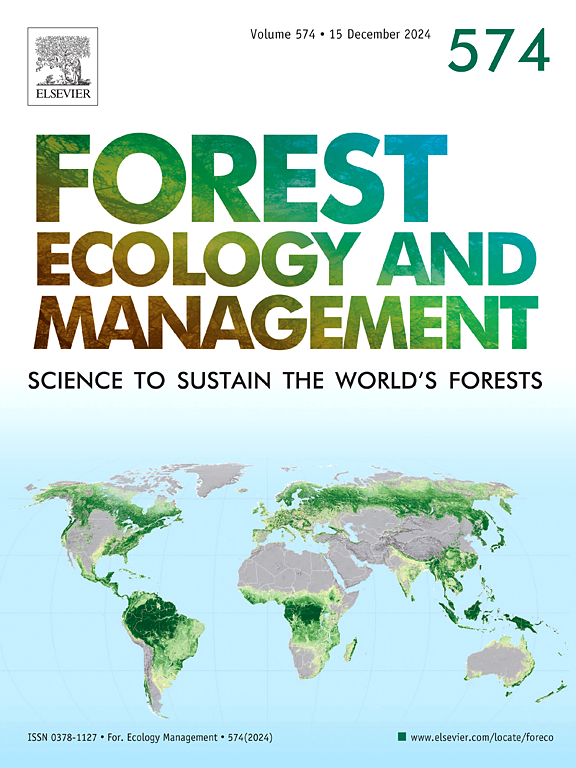功能特征和地理地形差异能否预测亚热带森林系统发育多样性的变化?对保育及管理的影响
IF 3.7
2区 农林科学
Q1 FORESTRY
引用次数: 0
摘要
通过森林管理提高树木多样性仍然是一个关键的生态挑战,但对系统发育多样性的关注有限,阻碍了全面的生物多样性增强战略。在本研究中,我们分析了中国东部亚热带非商业森林的570个样地(约36,000棵树),计算了5个系统发育多样性指数。通过Pearson相关性、冗余分析和结构方程建模,我们发现功能特性是系统发育多样性的最强预测因子(45.54 %方差),优于森林年龄/密度(36.97 %)和地理地形(20.23 %)。主要驱动因素包括针叶树百分比(17.6 %)、常绿树百分比(6.4 %)、海拔高度(4.1 %)和外生菌根(ECM)树丰度(3.6 %)。针叶树、常青树和ECM树比例高的样地MNTD(Mean Nearest Taxon Distance)、SesMPD(标准化平均对向距离)和SesMNTD(标准化MNTD)值分别是低比例样地的1.70倍、6.82倍和501.86倍。较高的海拔与Faith 's PD(系统发育多样性)增加相关,但与群集系统发育结构(SesMPD和SesMNTD减少)相关。较老的低密度林分的MNTD是较年轻的密度林分的1.28 ~ 25.08倍。结构方程模型表明,保留功能特性(针叶树、常绿树、ECM树)直接增加了系统发育的过度分散,特别是在高海拔、深土壤地区。这些发现强调了功能特征是亚热带森林系统发育多样性的可靠预测因子,为旨在最大化群落进化潜力的保护策略提供了可行的见解。本文章由计算机程序翻译,如有差异,请以英文原文为准。
Can functional identities and geo-topographical differences predict the subtropical forest phylogenetic diversity variations? Conservation and management implications
Enhancing tree diversity through forest management remains a key ecological challenge, yet limited attention to phylogenetic diversity has hindered comprehensive biodiversity enhancement strategies. In this study, we analyzed 570 plots (≈36,000 trees) across subtropical non-commercial forests in eastern China, calculating five phylogenetic diversity indices. Using Pearson correlations, redundancy analysis, and structural equation modeling, we identified functional identities as the strongest predictor of phylogenetic diversity (45.54 % variance), outperforming forest age/density (36.97 %) and geo-topography (20.23 %). Key drivers included conifer percentage (17.6 %), evergreen percentage(6.4 %), elevation (4.1 %), and ectomycorrhizal (ECM) tree abundance (3.6 %). Plots with higher proportions of conifers, evergreens, and ECM trees exhibited significantly higher MNTD(Mean Nearest Taxon Distance), SesMPD(Standardized Mean Pairwise Distance), and SesMNTD(Standarized MNTD) values (1.70 times, 6.82 times, and 501.86 times, respectively) than low-proportion plots. Higher elevations correlated with increased Faith’s PD (phylogenetic diversity) but clustered phylogenetic structures (reduced SesMPD and SesMNTD). Older, low-density forests showed 1.28–25.08 times higher MNTD than younger, dense stands. Structural equation modeling demonstrated that preserving functional identities (conifers, evergreens, ECM trees) directly increased phylogenetic overdispersion, particularly in high-elevation, deep-soil regions. These findings highlight that functional identities serve as robust predictors of phylogenetic diversity in subtropical forests, offering actionable insights for conservation strategies aimed at maximizing community evolutionary potential.
求助全文
通过发布文献求助,成功后即可免费获取论文全文。
去求助
来源期刊

Forest Ecology and Management
农林科学-林学
CiteScore
7.50
自引率
10.80%
发文量
665
审稿时长
39 days
期刊介绍:
Forest Ecology and Management publishes scientific articles linking forest ecology with forest management, focusing on the application of biological, ecological and social knowledge to the management and conservation of plantations and natural forests. The scope of the journal includes all forest ecosystems of the world.
A peer-review process ensures the quality and international interest of the manuscripts accepted for publication. The journal encourages communication between scientists in disparate fields who share a common interest in ecology and forest management, bridging the gap between research workers and forest managers.
We encourage submission of papers that will have the strongest interest and value to the Journal''s international readership. Some key features of papers with strong interest include:
1. Clear connections between the ecology and management of forests;
2. Novel ideas or approaches to important challenges in forest ecology and management;
3. Studies that address a population of interest beyond the scale of single research sites, Three key points in the design of forest experiments, Forest Ecology and Management 255 (2008) 2022-2023);
4. Review Articles on timely, important topics. Authors are welcome to contact one of the editors to discuss the suitability of a potential review manuscript.
The Journal encourages proposals for special issues examining important areas of forest ecology and management. Potential guest editors should contact any of the Editors to begin discussions about topics, potential papers, and other details.
 求助内容:
求助内容: 应助结果提醒方式:
应助结果提醒方式:


